|
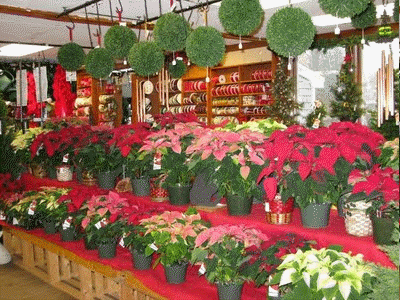 Many
potted plants are associated with the holiday season either given as
gifts, used as seasonal decoration, or simply to provide colorful
bloom indoors during winter. With proper care, many holiday plants
will remain attractive through the holidays and beyond. Some can
become permanent house plants that can give repeat performances each
holiday season. Many
potted plants are associated with the holiday season either given as
gifts, used as seasonal decoration, or simply to provide colorful
bloom indoors during winter. With proper care, many holiday plants
will remain attractive through the holidays and beyond. Some can
become permanent house plants that can give repeat performances each
holiday season.
Beautiful plants abound during the holiday
season. Some such as poinsettia, Christmas cactus, Norfolk Island
pine, amaryllis, paperwhite, cyclamen, and kalanchoe are familiar,
traditional holiday plants.
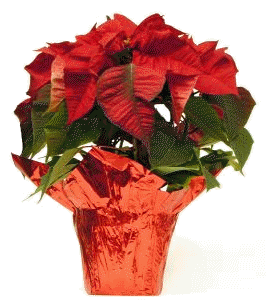 Oftentimes,
holiday plants have their pots wrapped in a decorative foil or
plastic. When watering it's important to remove the pot from the
wrapper to allow excess water to drain from the soil. Water that sits
inside the wrapper will cause the roots to rot. One way to keep the
decorative wrapper on the pot but allow water to drain freely is to
poke holes in the bottom of the wrapper that line up with the
drainage holes in the bottom of the pot. That way when the plant is
watered it won't sit in water. Oftentimes,
holiday plants have their pots wrapped in a decorative foil or
plastic. When watering it's important to remove the pot from the
wrapper to allow excess water to drain from the soil. Water that sits
inside the wrapper will cause the roots to rot. One way to keep the
decorative wrapper on the pot but allow water to drain freely is to
poke holes in the bottom of the wrapper that line up with the
drainage holes in the bottom of the pot. That way when the plant is
watered it won't sit in water. |
|
Another important consideration with holiday
plants is outdoor temperatures whenever the plants are transported
either from the store or when brought to someone else as a gift. The
cold can kill plants so it's important to wrap them up and totally
enclose them inside a paper sleeve that is folded over and stapled at
the top or placed in a sealed plastic bag. On cold days don't let the
plants sit inside the vehicle when the heat is off.
The key to success in keeping a holiday plant looking good is to know
the plant and the growing conditions it likes and matching those to
the environment inside the home. Cultural conditions such as light,
temperature, watering, humidity, and fertilizing are the key factors
relating to the health of any indoor plant. Choosing the right
location to grow the plant in the home can make all the difference in
the world.
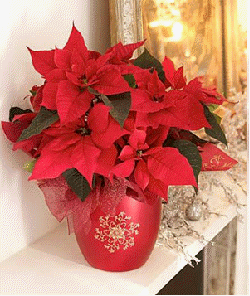 Poinsettia
is the most popular Christmas potted plant. There are many different
colors in addition to red and different styles from which to choose,
but all are cared for the same way. Poinsettia does best in a bright,
sunny window. Place the plant where it will receive four to six hours
of direct sunlight. Average room temperature around 70 degrees during
the day and around 60 degrees at night is ideal. Water the plant when
the surface of the soil is dry to the touch. In winter, heating
systems dry out the air, but a simple way to add humidity is to set
the pot on top of a saucer of pebbles that are kept moist.
Poinsettias are sensitive to drafts, so place them away from doors or
drafty windows. Fertilization is not necessary until spring.
Poinsettias can be saved from year to year and be made to rebloom in
time for the holidays by providing a dark treatment in fall. Poinsettia
is the most popular Christmas potted plant. There are many different
colors in addition to red and different styles from which to choose,
but all are cared for the same way. Poinsettia does best in a bright,
sunny window. Place the plant where it will receive four to six hours
of direct sunlight. Average room temperature around 70 degrees during
the day and around 60 degrees at night is ideal. Water the plant when
the surface of the soil is dry to the touch. In winter, heating
systems dry out the air, but a simple way to add humidity is to set
the pot on top of a saucer of pebbles that are kept moist.
Poinsettias are sensitive to drafts, so place them away from doors or
drafty windows. Fertilization is not necessary until spring.
Poinsettias can be saved from year to year and be made to rebloom in
time for the holidays by providing a dark treatment in fall.
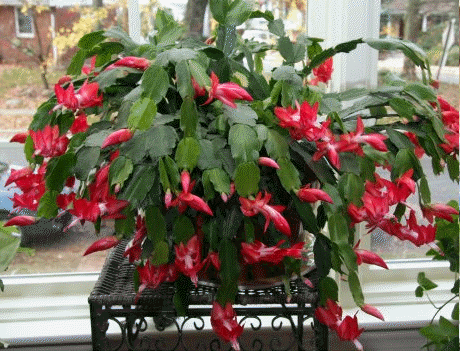 Christmas
cactus is a familiar holiday plant with its brightly-colored,
tubular flowers at the tips of its segmented stems. It is easy to
grow. Christmas cactus does best in bright, indirect light. Ideal
temperatures are around 70 degrees during the day and 60 degrees
during nighttime. Water Christmas cactus when the top half of the
soil is dry. Fertilize when the plant is actively growing, from
spring through summer. Christmas cactus will drop its flower buds if
it is moved at the stage when the buds are small and beginning to
show color. Wait until the flowers are opened before moving it to
another location. Christmas cactus, as well as poinsettia, is also a
short-day plant, meaning it blooms when nights are long. It can also
be given a dark treatment in fall, however Christmas cactus will
flower if night temperatures are low, regardless of daylength. Giving
the plant night temperatures of 50 degrees from early November until
the plant sets buds is all that's needed. Christmas
cactus is a familiar holiday plant with its brightly-colored,
tubular flowers at the tips of its segmented stems. It is easy to
grow. Christmas cactus does best in bright, indirect light. Ideal
temperatures are around 70 degrees during the day and 60 degrees
during nighttime. Water Christmas cactus when the top half of the
soil is dry. Fertilize when the plant is actively growing, from
spring through summer. Christmas cactus will drop its flower buds if
it is moved at the stage when the buds are small and beginning to
show color. Wait until the flowers are opened before moving it to
another location. Christmas cactus, as well as poinsettia, is also a
short-day plant, meaning it blooms when nights are long. It can also
be given a dark treatment in fall, however Christmas cactus will
flower if night temperatures are low, regardless of daylength. Giving
the plant night temperatures of 50 degrees from early November until
the plant sets buds is all that's needed.
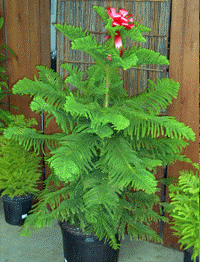 Norfolk
Island pine is an indoor plant that comes in many sizes from
table-top to big floor plants. It's often decorated with miniature
ornaments as a living Christmas tree. Norfolk Island pine will
tolerate low light and average-to-cool room temperatures. Let the
soil dry out slightly between waterings. Lower branch loss can be a
problem in dry homes. Remedy this by setting the pot on a saucer
filled with pebbles that are kept moist. Fertilize Norfolk Island
pine once every two months during spring and summer. Norfolk
Island pine is an indoor plant that comes in many sizes from
table-top to big floor plants. It's often decorated with miniature
ornaments as a living Christmas tree. Norfolk Island pine will
tolerate low light and average-to-cool room temperatures. Let the
soil dry out slightly between waterings. Lower branch loss can be a
problem in dry homes. Remedy this by setting the pot on a saucer
filled with pebbles that are kept moist. Fertilize Norfolk Island
pine once every two months during spring and summer.
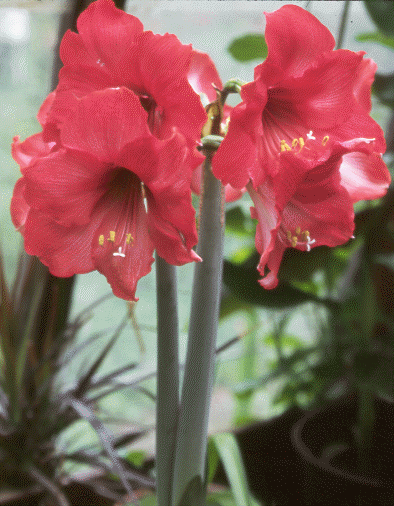 One
of the most elegant, stately plants of the holiday season and beyond
is amaryllis. This winter-blooming, indoor bulb has enormous,
trumpet-shaped flowers in striking colors and shapes. The bulb from
which the flowers emerge is itself very large, often the size of a
grapefruit. Blooming in early winter and continuing into early
spring, amaryllis produces a tall, hollow, often leafless, flower
stalk topped with four to five flowers arranged in a circular
pattern. Each lily-shaped flower is large, up to 10 inches across.
The flower stalk is tall, usually 18 to 24 inches tall. It is not
uncommon for one amaryllis bulb to produce two flower stalks, each
with four to five flowers. This profusion of colorful bloom from one
bulb is a welcome sight during the drab, gray winter months when
little else is blooming. Once the bulb has finished flowering, its
long, thin, sword-like foliage remains well into summer. In late
summer its foliage withers and the bulb goes dormant. Stop watering
the pot at this time, then resume watering eight to 10 weeks before
Christmas so it will be in bloom again at the proper time. One
of the most elegant, stately plants of the holiday season and beyond
is amaryllis. This winter-blooming, indoor bulb has enormous,
trumpet-shaped flowers in striking colors and shapes. The bulb from
which the flowers emerge is itself very large, often the size of a
grapefruit. Blooming in early winter and continuing into early
spring, amaryllis produces a tall, hollow, often leafless, flower
stalk topped with four to five flowers arranged in a circular
pattern. Each lily-shaped flower is large, up to 10 inches across.
The flower stalk is tall, usually 18 to 24 inches tall. It is not
uncommon for one amaryllis bulb to produce two flower stalks, each
with four to five flowers. This profusion of colorful bloom from one
bulb is a welcome sight during the drab, gray winter months when
little else is blooming. Once the bulb has finished flowering, its
long, thin, sword-like foliage remains well into summer. In late
summer its foliage withers and the bulb goes dormant. Stop watering
the pot at this time, then resume watering eight to 10 weeks before
Christmas so it will be in bloom again at the proper time.
 Paperwhites
are a kind of tender narcissus that can be forced into bloom quite
easily and quickly without a cold treatment. It's a fun project for
children and adults to plant the bulbs and watch them grow and bloom.
Paperwhites are extremely fragrant and will fill a room with their
scent. There are three types of paperwhites. The most common one has
large clusters of fragrant, pure white flowers. 'Soleil d'Or' has
golden-yellow flowers with an orange "cup" in the center.
Chinese sacred lily has white flowers and a bright-yellow cup. All
three paperwhites are grown the same way. This method doesn't involve
soil. Using a solid, shallow bowl, pour pea gravel halfway to the
rim. The pea gravel will anchor the bulbs. Set the bulbs, pointed end
upright, onto the gravel. Place the bulbs side by side, filling the
container. Add water so that just the bottom of the bulbs are the
touching the water. Now add more gravel carefully filling in the
spaces around each bulb. Then set the container in a cool location in
the home for several weeks. During this time roots will develop.
Check the water level regularly and add Paperwhites
are a kind of tender narcissus that can be forced into bloom quite
easily and quickly without a cold treatment. It's a fun project for
children and adults to plant the bulbs and watch them grow and bloom.
Paperwhites are extremely fragrant and will fill a room with their
scent. There are three types of paperwhites. The most common one has
large clusters of fragrant, pure white flowers. 'Soleil d'Or' has
golden-yellow flowers with an orange "cup" in the center.
Chinese sacred lily has white flowers and a bright-yellow cup. All
three paperwhites are grown the same way. This method doesn't involve
soil. Using a solid, shallow bowl, pour pea gravel halfway to the
rim. The pea gravel will anchor the bulbs. Set the bulbs, pointed end
upright, onto the gravel. Place the bulbs side by side, filling the
container. Add water so that just the bottom of the bulbs are the
touching the water. Now add more gravel carefully filling in the
spaces around each bulb. Then set the container in a cool location in
the home for several weeks. During this time roots will develop.
Check the water level regularly and add |



 Many
potted plants are associated with the holiday season either given as
gifts, used as seasonal decoration, or simply to provide colorful
bloom indoors during winter. With proper care, many holiday plants
will remain attractive through the holidays and beyond. Some can
become permanent house plants that can give repeat performances each
holiday season.
Many
potted plants are associated with the holiday season either given as
gifts, used as seasonal decoration, or simply to provide colorful
bloom indoors during winter. With proper care, many holiday plants
will remain attractive through the holidays and beyond. Some can
become permanent house plants that can give repeat performances each
holiday season. Oftentimes,
holiday plants have their pots wrapped in a decorative foil or
plastic. When watering it's important to remove the pot from the
wrapper to allow excess water to drain from the soil. Water that sits
inside the wrapper will cause the roots to rot. One way to keep the
decorative wrapper on the pot but allow water to drain freely is to
poke holes in the bottom of the wrapper that line up with the
drainage holes in the bottom of the pot. That way when the plant is
watered it won't sit in water.
Oftentimes,
holiday plants have their pots wrapped in a decorative foil or
plastic. When watering it's important to remove the pot from the
wrapper to allow excess water to drain from the soil. Water that sits
inside the wrapper will cause the roots to rot. One way to keep the
decorative wrapper on the pot but allow water to drain freely is to
poke holes in the bottom of the wrapper that line up with the
drainage holes in the bottom of the pot. That way when the plant is
watered it won't sit in water. Poinsettia
is the most popular Christmas potted plant. There are many different
colors in addition to red and different styles from which to choose,
but all are cared for the same way. Poinsettia does best in a bright,
sunny window. Place the plant where it will receive four to six hours
of direct sunlight. Average room temperature around 70 degrees during
the day and around 60 degrees at night is ideal. Water the plant when
the surface of the soil is dry to the touch. In winter, heating
systems dry out the air, but a simple way to add humidity is to set
the pot on top of a saucer of pebbles that are kept moist.
Poinsettias are sensitive to drafts, so place them away from doors or
drafty windows. Fertilization is not necessary until spring.
Poinsettias can be saved from year to year and be made to rebloom in
time for the holidays by providing a dark treatment in fall.
Poinsettia
is the most popular Christmas potted plant. There are many different
colors in addition to red and different styles from which to choose,
but all are cared for the same way. Poinsettia does best in a bright,
sunny window. Place the plant where it will receive four to six hours
of direct sunlight. Average room temperature around 70 degrees during
the day and around 60 degrees at night is ideal. Water the plant when
the surface of the soil is dry to the touch. In winter, heating
systems dry out the air, but a simple way to add humidity is to set
the pot on top of a saucer of pebbles that are kept moist.
Poinsettias are sensitive to drafts, so place them away from doors or
drafty windows. Fertilization is not necessary until spring.
Poinsettias can be saved from year to year and be made to rebloom in
time for the holidays by providing a dark treatment in fall. Christmas
cactus is a familiar holiday plant with its brightly-colored,
tubular flowers at the tips of its segmented stems. It is easy to
grow. Christmas cactus does best in bright, indirect light. Ideal
temperatures are around 70 degrees during the day and 60 degrees
during nighttime. Water Christmas cactus when the top half of the
soil is dry. Fertilize when the plant is actively growing, from
spring through summer. Christmas cactus will drop its flower buds if
it is moved at the stage when the buds are small and beginning to
show color. Wait until the flowers are opened before moving it to
another location. Christmas cactus, as well as poinsettia, is also a
short-day plant, meaning it blooms when nights are long. It can also
be given a dark treatment in fall, however Christmas cactus will
flower if night temperatures are low, regardless of daylength. Giving
the plant night temperatures of 50 degrees from early November until
the plant sets buds is all that's needed.
Christmas
cactus is a familiar holiday plant with its brightly-colored,
tubular flowers at the tips of its segmented stems. It is easy to
grow. Christmas cactus does best in bright, indirect light. Ideal
temperatures are around 70 degrees during the day and 60 degrees
during nighttime. Water Christmas cactus when the top half of the
soil is dry. Fertilize when the plant is actively growing, from
spring through summer. Christmas cactus will drop its flower buds if
it is moved at the stage when the buds are small and beginning to
show color. Wait until the flowers are opened before moving it to
another location. Christmas cactus, as well as poinsettia, is also a
short-day plant, meaning it blooms when nights are long. It can also
be given a dark treatment in fall, however Christmas cactus will
flower if night temperatures are low, regardless of daylength. Giving
the plant night temperatures of 50 degrees from early November until
the plant sets buds is all that's needed. Norfolk
Island pine is an indoor plant that comes in many sizes from
table-top to big floor plants. It's often decorated with miniature
ornaments as a living Christmas tree. Norfolk Island pine will
tolerate low light and average-to-cool room temperatures. Let the
soil dry out slightly between waterings. Lower branch loss can be a
problem in dry homes. Remedy this by setting the pot on a saucer
filled with pebbles that are kept moist. Fertilize Norfolk Island
pine once every two months during spring and summer.
Norfolk
Island pine is an indoor plant that comes in many sizes from
table-top to big floor plants. It's often decorated with miniature
ornaments as a living Christmas tree. Norfolk Island pine will
tolerate low light and average-to-cool room temperatures. Let the
soil dry out slightly between waterings. Lower branch loss can be a
problem in dry homes. Remedy this by setting the pot on a saucer
filled with pebbles that are kept moist. Fertilize Norfolk Island
pine once every two months during spring and summer. One
of the most elegant, stately plants of the holiday season and beyond
is amaryllis. This winter-blooming, indoor bulb has enormous,
trumpet-shaped flowers in striking colors and shapes. The bulb from
which the flowers emerge is itself very large, often the size of a
grapefruit. Blooming in early winter and continuing into early
spring, amaryllis produces a tall, hollow, often leafless, flower
stalk topped with four to five flowers arranged in a circular
pattern. Each lily-shaped flower is large, up to 10 inches across.
The flower stalk is tall, usually 18 to 24 inches tall. It is not
uncommon for one amaryllis bulb to produce two flower stalks, each
with four to five flowers. This profusion of colorful bloom from one
bulb is a welcome sight during the drab, gray winter months when
little else is blooming. Once the bulb has finished flowering, its
long, thin, sword-like foliage remains well into summer. In late
summer its foliage withers and the bulb goes dormant. Stop watering
the pot at this time, then resume watering eight to 10 weeks before
Christmas so it will be in bloom again at the proper time.
One
of the most elegant, stately plants of the holiday season and beyond
is amaryllis. This winter-blooming, indoor bulb has enormous,
trumpet-shaped flowers in striking colors and shapes. The bulb from
which the flowers emerge is itself very large, often the size of a
grapefruit. Blooming in early winter and continuing into early
spring, amaryllis produces a tall, hollow, often leafless, flower
stalk topped with four to five flowers arranged in a circular
pattern. Each lily-shaped flower is large, up to 10 inches across.
The flower stalk is tall, usually 18 to 24 inches tall. It is not
uncommon for one amaryllis bulb to produce two flower stalks, each
with four to five flowers. This profusion of colorful bloom from one
bulb is a welcome sight during the drab, gray winter months when
little else is blooming. Once the bulb has finished flowering, its
long, thin, sword-like foliage remains well into summer. In late
summer its foliage withers and the bulb goes dormant. Stop watering
the pot at this time, then resume watering eight to 10 weeks before
Christmas so it will be in bloom again at the proper time. Paperwhites
are a kind of tender narcissus that can be forced into bloom quite
easily and quickly without a cold treatment. It's a fun project for
children and adults to plant the bulbs and watch them grow and bloom.
Paperwhites are extremely fragrant and will fill a room with their
scent. There are three types of paperwhites. The most common one has
large clusters of fragrant, pure white flowers. 'Soleil d'Or' has
golden-yellow flowers with an orange "cup" in the center.
Chinese sacred lily has white flowers and a bright-yellow cup. All
three paperwhites are grown the same way. This method doesn't involve
soil. Using a solid, shallow bowl, pour pea gravel halfway to the
rim. The pea gravel will anchor the bulbs. Set the bulbs, pointed end
upright, onto the gravel. Place the bulbs side by side, filling the
container. Add water so that just the bottom of the bulbs are the
touching the water. Now add more gravel carefully filling in the
spaces around each bulb. Then set the container in a cool location in
the home for several weeks. During this time roots will develop.
Check the water level regularly and add
Paperwhites
are a kind of tender narcissus that can be forced into bloom quite
easily and quickly without a cold treatment. It's a fun project for
children and adults to plant the bulbs and watch them grow and bloom.
Paperwhites are extremely fragrant and will fill a room with their
scent. There are three types of paperwhites. The most common one has
large clusters of fragrant, pure white flowers. 'Soleil d'Or' has
golden-yellow flowers with an orange "cup" in the center.
Chinese sacred lily has white flowers and a bright-yellow cup. All
three paperwhites are grown the same way. This method doesn't involve
soil. Using a solid, shallow bowl, pour pea gravel halfway to the
rim. The pea gravel will anchor the bulbs. Set the bulbs, pointed end
upright, onto the gravel. Place the bulbs side by side, filling the
container. Add water so that just the bottom of the bulbs are the
touching the water. Now add more gravel carefully filling in the
spaces around each bulb. Then set the container in a cool location in
the home for several weeks. During this time roots will develop.
Check the water level regularly and add